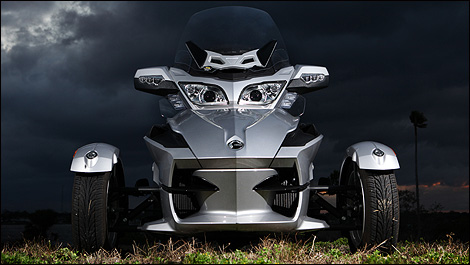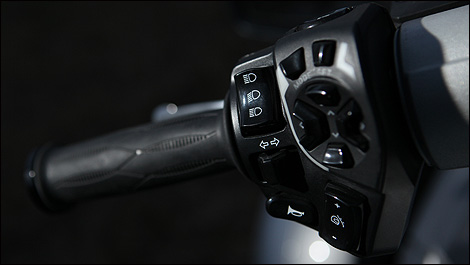Click here for the
2010 Spyder RT-S review.
The Spyder’s 2-front – 1-rear wheel configuration poses interesting, and I suspect, unexpected challenges for BRP engineers when it came to make it safe and exciting to ride. Other factors such as weight distribution, mass centralisation and the location of the center of gravity, both fore-and-aft, and height), and the need for a low look at the rear must have complicated their lives.
 |
| A mean front look that combines style with aerodynamic efficiency to manage airflow over the large frontal area and optimize use of air for cooling the driver and the engine, and optimize stability at higher speeds. Photo: Philippe Champoux/Auto123.com |
The machine had to be as idiot-proof as it could be given that low-skill drivers were going to buy them, and the last thing makers BRP needed was a major lawsuit that could be blamed on “unsafe” behaviour of the machine.
Hence the creation of the bespoke Vehicle Stability System (VSS), a set of mostly interconnected systems developed in cooperation with Bosch, at great cost I am sure. The VSS governs every reaction of the bike to driver input, based on the machine status at any given time.
Vehicle Stability System (VSS)
BRP documents at (http://spyder.brp.com/en-CA/See/Can-Am/Showroom/Showroom-RS.html) discuss the various electronic systems that make up the VSS and perform the following major functions:
Electronic Brake Distribution (EBD) and ABS
Applying the brakes with the right foot pedal only (Like in a car!) lets the braking system decide how much pressure to send to the front and rear, based on moving as much effort as possible to the rear, and thus leaving extra traction at the front for direction changes. The ABS manage the overall retardation when the machine approaches the traction limits of any one contact patch, much in the traditional fashion.
Traction Control
Engine torque is reduced when the ABS sensors detect a higher speed at the rear wheel than the front. This prevents accidental as well as voluntary power slides on corner exit.
 |
| Left side controls include turn indicators, low-high-flash headlight, windshield height adjustment, horn, and another set of buttons to control the audio system and other electronics like reverse gear interlock, and to shift gears on the semi-automatic gearbox (Photo: Philippe Champoux/Auto123.com) |

